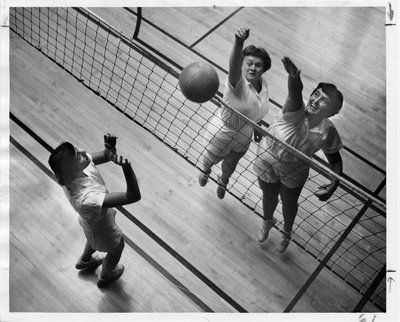Women have been competing athletically at Oregon State for nearly as long as male students. While intercollegiate athletics at this institution can trace their beginning to the first football game in 1893, women’s basketball is nearly as old, with the first team fielded in 1898, some three years before the men began took to the court.
For the first two decades of the twentieth century, women athletes at Oregon Agricultural College were encouraged to compete in head-to-head competition, both within the institution and against other schools. In the 1920s, prompted in part by a broadly held view that intense physical exertion could hamper a woman’s ability to bear children, the aspiring female athlete at Oregon State was steered intentionally toward intramural and recreational pursuits. In those infrequent instances where a Beaver women’s team might travel to another school, squads were occasionally intermingled in an effort to reduce the competitive spirit. It was also not uncommon for games to conclude with a tea social.
Beginning in the 1950s, all women’s athletics on campus were administered by the Women’s Recreation Association, a student organization that oversaw intramural activities ranging from basketball, volleyball and polo, to jacks, croquet and tetherball tournaments. The full spectrum of women’s physical activity during this time period was confined to either the Women’s Building or the Women’s Building field, where Austin Hall and the Learning Innovation Center are located today.
The sporting environment nationwide took a radical turn in the 1970s with the passage and implementation of Title IX. In Corvallis, as with many institutions, the mandated transition toward parity in support was anything but smooth, but over time women’s athletics gained a foothold and began to develop a tradition. Today, the gymnastics program stands as OSU’s most successful women’s team, having competed in the postseason for forty-four straight years and producing seven individual national champions. More recently, the women’s basketball team has established itself as among the nation’s best, reaching the NCAA tournament in five consecutive seasons, including trips to the Final Four in 2016, and the Elite Eight in 2018.
OSU has also produced at least sixteen female Olympians, the first being Jean Saubert, who won two slalom medals at the 1964 Innsbruck games. Another Olympian, 1984 gold medalist Carol Menken, is considered the greatest basketball player in school history. A transfer from Linn Benton Community College, Menken earned first team All American status in 1981 and still holds multiple school records. Remarkably, on exactly one-hundred occasions, an OSU women’s basketball player has scored thirty or more points in a game. Menken accounts for thirty-six of those games, including fifty-one, forty-six and forty-three point tallies that remain the top three scoring efforts in program history.

